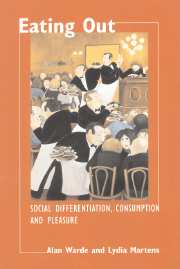Book contents
- Frontmatter
- Contents
- List of illustrations
- List of tables
- Acknowledgements
- 1 Studying eating out
- Part I Modes of provision
- 2 The development of the habit of eating out in the UK
- 3 The meanings of eating out
- Part II Access
- Part III Delivery
- Part IV Enjoyment: the attractions of eating out
- Part V Conclusion
- Methodological appendix: data collection and analysis
- References
- Index
2 - The development of the habit of eating out in the UK
Published online by Cambridge University Press: 22 September 2009
- Frontmatter
- Contents
- List of illustrations
- List of tables
- Acknowledgements
- 1 Studying eating out
- Part I Modes of provision
- 2 The development of the habit of eating out in the UK
- 3 The meanings of eating out
- Part II Access
- Part III Delivery
- Part IV Enjoyment: the attractions of eating out
- Part V Conclusion
- Methodological appendix: data collection and analysis
- References
- Index
Summary
This chapter sketches developments in the provision of opportunities to eat out and reflects on the terminology used to describe different venues. It then reviews the available, limited, evidence about the features of three modes of provision – the commercial–retail sector, the institutional catering sector and the communal mode of entertaining kin, friends and acquaintances. This information, derived from secondary sources, is necessary to contextualise the behaviour reported by our interviewees and respondents. Some understanding of provisioning is also required for theoretical reasons, since our analytic approach requires a comprehensive appreciation of all stages in production–consumption cycles.
There are many types of place away from home where currently people may eat a meal in Britain. Some of these are commercial establishments which specialise entirely in the provision of food. Thus we have, among others, cafés, restaurants, steakhouses, diners, brasseries, bistros, pizzerias, kebab-houses, grill rooms, coffee bars, teashops, ice cream parlours, food courts, snack bars, refreshment rooms, transport cafes and service stations, buffets and canteens. There are commercial places to eat which are not primarily devoted to food provision, like the tavern, the pub, the wine bar, the hotel, the in-store restaurant, the boarding house and the motel. There are commercial establishments that provide food to be eaten off the premises – fish and chip shops, lunch counters, sandwich bars and other purveyors of take away or carry out foods.
- Type
- Chapter
- Information
- Eating OutSocial Differentiation, Consumption and Pleasure, pp. 21 - 41Publisher: Cambridge University PressPrint publication year: 2000



